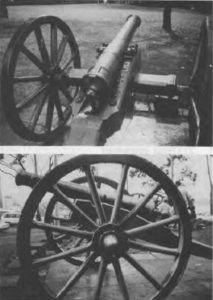- Author
- A.N. Other and NHSA Webmaster
- Subjects
- History - pre-Federation
- Tags
-
- RAN Ships
- None noted.
- Publication
- September 1990 edition of the Naval Historical Review (all rights reserved)
On 11 February, 1879 the following announcement was published in the West Australian Government Gazette.
Colonial Secretary’s Office Perth, 10th February 1879 His Excellency the Governor has been pleased to approve the formation of a Naval Volunteer Force at Fremantle under the designation of ‘Fremantle Naval Volunteers’ and of the following gentleman officiating in the capacity stated opposite his name pending the result of the examination to be held before a Military Board assembled under the Government Notification of 20th April 1875.
George A. Forsyth, Esquire, Lieut, Commanding.
By His Excellency’s Command ROGER TUCKFD GOLDSWORTHY Colonial Secretary

With the publishing of the above notice in the Government Gazette the Fremantle Naval Volunteers were established under the command of Lieutenant George A. Forsyth. Through its short history the unit was unofficially and in official correspondence, known by a number of names. These included: Fremantle Naval Artillery, Naval Artillery Volunteers and the Naval Brigade. The unit, as the above names imply, was a militia artillery unit formed to help provide for the defence of the port of Fremantle and its environs. Earlier recommendations for the construction of fixed defences at Fremantle, including a martello tower, had not been progressed with as they were all considered to be too expensive. A volunteer unit, however, required minimal government expenditure and gave the government a feeling that they were actually providing for the defence of the colony. As a volunteer unit the Fremantle Naval Volunteers did not have a formal barracks. They were to use some of the buildings at the Fremantle Immigration Depot as a gun shed, armoury and bandroom. Apart from providing buildings the only other form of Government assistance was the provision of weapons and some items of uniform.
The actual formation of a volunteer unit, under the auspices of West Australian Volunteer Force Ordinances of 1861, was not gazetted until the Military Council was satisfied that a sufficient number of personnel were enrolled so as to make the unit viable and that they had attained a satisfactory standard of drill.
From the very start, membership of the Fremantle Naval Volunteers was restricted to ex-Royal Navy personnel or merchant seamen of good character. As a result of this the uniforms and rank structure of the unit were all naval in nature. The weapons for the Fremantle Naval Volunteers were provided by the West Australian Government and consisted of Snider Naval Pattern rifles and two 5 pdr brass field guns.
The field guns, which were reportedly cast in 1720 and 1739, had been recommissioned for service during the Peninsular War. The report of the 1901 Military Committee of Inquiry lists two 6 pdr smooth bore guns as being located at Fremantle. These two guns are recorded as having been cast by H & C King in 1813 and 1814 and they are most likely the original guns used by the Fremantle Naval Volunteers. The second date would be the year that these weapons were reworked for further service. Both of these guns are currently mounted at Kings Park, Perth. The effectiveness of the Naval Volunteers’s was severely limited, not only because of their age, but also because the unit did not have any limbers or wagons for moving them.
Due to the lack of limbers the guns left their depot on only rare occasions, one such occasion was when the Naval Volunteers attended the camp and manoeuvres at Albion in 1884. During these manoeuvres the Fremantle Naval Volunteers were used as field artillery to support other volunteer units. Should the unit have ever been called out it was intended that, supported by a force of twenty infantry, they were to take up a position on the northern end of the railway bridge crossing the Swan River at Fremantle. Their function, as stated by the Colonial Secretary in a letter to the Governor on 11 January 1882, would be to keep open a line of retreat and protect the rear of the main force. This was at variance with the original intention of using the force to defend Fremantle harbour. Considering that the force was intended to defend Fremantle not from a major naval assault but a ‘filibustering expedition’, there is every likelihood that the raiders would have departed before the Naval Volunteers could have been mobilised. The reason for the delay in mobilising the Fremantle Naval Volunteers was that under West Australia’s Volunteer Act the Governor was required to issue a proclamation in the Gazette before the volunteers could be called out for active service.




